Growing Instructions
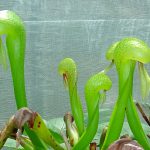
SPECIES INFORMATION: The genus/species Darlingtonia, commonly known as the cobra plant/lily or the California pitcher plant, is a part of the same family as Sarracenia, but is native only to parts of the Pacific Northwest. It gets its name from the curved, hooded traps and their appendages, which hang downward in the shaped of a forked tongue. The plant employs a passive pitcher to capture its prey. Unlike its American pitcher plant cousins, the pitcher of a cobra plant has downward pointing hairs inside, thus once an insect enters it only goes one way. And, if you follow the pitcher from the bottom of the plant, the traps twist to face 180 degrees from the stalk's original direction.
GROWING INSTRUCTIONS:
Climate: Darlingtonia grows naturally in the cold bogs along the west coast from Southern Washington to high altitudes of northern California. Therefore, the most important thing to remember is that the roots of a Darlingtonia must be kept cool; these plants have cool water moving lightly over their roots. Air temperatures have a good range, the cobra lily taking anything from just below freezing to high summer temperatures of about 85F in the shade. In warmer climates it is highly suggested to lay ice cubes on the soil or water with refrigerated water, if the roots temperature rises above 70F the plant will not survive. Also there needs to be a fluctuation of day to night temperatures during the summer, days can be 85F but nights or soil temperature needs to be 50F or below. This might mean the difference between life and death for your cobra.
Soil:
The cobra lily's soil mixture is based almost entirely upon its need to keep its roots cool. A good airy mixture that easily allows water to circulate is the best suggestion, such as:
- 1 part sphagnum peat moss to 1 part perlite and/or sand
- It is a good idea to lace the top of the pot with live sphagnum moss to help retain water and also works as a heat dissipater.
Dormancy: As with most other carnivores, the dormancy period of winter is essential. Keep the plant above freezing, about 35 degrees Fahrenheit. Trap growth will stop and some of the plant will die back. This, of course, is normal.
Feeding: As with most carnivorous plants, Darlingtonia can basically capture all the food it needs to survive. Do not fertilize this plant. It is not necessary and will likely kill the plant. If you think the plant is lacking nutrients, a cricket or fly or wasp, etc., down the trap every now and then is ok.
Propagation: The cobra plant is very adept for sexual reproduction. When the plant flowers in spring, you can induce it yourself. Asexual reproduction is possible through the removal of the stolons from the rhizome during the spring.Nepenthes, or the tropical pitcher plant, are once again a passive trap plant, whose traps resemble the shape of an urn or pitcher. The genus is divided into two main groups, highland and lowland Nepenthes. It is home to some of the carnivorous plants' biggest pitchers, and the oldest of Nepenthes plants have been known to have eaten small birds. These are some of the most sought after plants in cultivation and are perhaps some of the most deadly. These plants can grow to be all different sizes and even the pitchers take on different shapes. For a better look at the diverse looking species, check out the photos page.
Climate-Highland: Grows in mildly humid to semi-arid climates, with temperatures best in the range of 65-85 degrees Fahrenheit
Lowland: Usually more in tropical zones, the lowland Nepenthes best takes 55-80 degrees Fahrenheit and a considerably higher humidity.
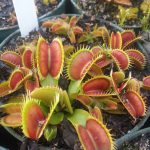
SPECIES INFORMATION: Venus fly trap plants lure, capture and digest insects. If the prey attracted by the sweet odor touches the trigger hairs the trap snaps shut, catching its victim. After digesting its meal it opens in a few days, ready for another victim.
GROWING INSTRUCTIONS: Flytraps like warm humid conditions with summer temps between 70-100 degrees. Make sure the soil is kept moist during the growing season, from May through October. Do not keep these plants setting in water unless they are in direct sunlight, as they have a tendency to rot if set in water in dimmer light. Use distilled soft well water or rain water.
During the winter months keep soil just damp and put in a cool area, such as a dark garage, winter temps should be between 35-50 degrees. You will notice the plant in the dormant/bulb state often the traps will all turn black be assured the plant will come out of this in the spring with warm temperatures and good sunlight. You will want to spray your plant with a fungicide if they are going to observe dormancy in your garage, outside it is unneeded. If you have the plants in a bog outside they will withstand a cooler winter, but if the temperature is going to drop below 30 degrees for an extended period of time cover them with some pine needles for protection.
Transplanting should be done in the spring before vigorous growth. Plant in a mix of 70% peat moss and 30% perlite or pumice. The main pests for these plants are aphids, which cause the leaves to curl. To remove these pests dip pot into a bucket of water and gently wash them off the leaves or just put pot into a bucket of water, out of the direct sun, with the plant submerged for about a week. These plants do not need to be fed for survival. The insect acts as a natural fertilizer. Do not feed hamburger, it will kill the plant do to its fat content. Also don't try to feed it your finger. Live insects only.
HAPPY GROWING!!!
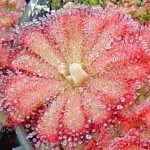
SPECIES INFORMATION: Drosera is a hugely diverse genus. It's species may be found all over the world, in Africa, N. America, S. America, Australia, even the tropics. Humidity is generally a requirement for all species.
Climate: Drosera is a hugely diverse genus. It's species may be found all over the world, in Africa, N. America, S. America, Australia, even the tropics. Humidity is generally a requirement for all species.
Tuberous: Tuberous species generally require summer time temperatures between seventy five and ninety degrees. Strong light is also required. It is recommended to have a 13-14 hour photo period a day. Winter temperatures can range anywhere between 30 and 50 degrees. High humidity is required to grow these plants.
Temperate: Summer time temperatures between 70 and 90 degrees are necessary. High humidity is also a must during the growing season as it decreases when it enters dormancy.
Tropical: Summer time temperatures should between 75 and 95 degrees with a high level of humidity. Wintertime temperatures should be between 60 degrees and 80. Intense light is required with more then a twelve hour photo period for winter and summer time.
Pygmy: In the summer time, temperatures between eighty and one hundred are required with drier conditions.
Dormancy: Dormancy is only required for a few groupings of Drosera and for varying amounts of time. See below for specific instructions for the groupings.
Tuberous: The tuberous plant goes dormant in the summer time so dry conditions are necessary. Keep temperatures high.
Temperate: Dormancy is required in the winter time for about 5 months. Humidity and moisture should be dramatically reduced during this time. Dormancy temperatures should be between 35 and 45 degrees.
Tropical: There is no dormancy requirements for tropical drosera.
Pygmy: It is characteristic of pygmy drosera to go dormant during the summer in hot temperatures but is not always necessary. This is simply a mechanism for surviving harsh conditions.
Feeding: Drosera may be fed insects based on it's size. Many growers prefer egg whites however because they do not remain on the tentacles of the plant. Don't over feed it though.
Watering: All drosera require lots of water so the tray method is the best to use. Remember to never use tap water as the chemicals will build up in the plant and kill it. Try to use rain water or desalinized store bought water.
Soil: Generally a drosera will prefer a two parts peat to one part silica sand mix. Like dionaea this can be varied. Pumice and perlite may also be work in soil mediums. Keep the medium of the plants very moist but remember that setting them in water might encourage unwanted rot. As for other carnivores, the rules concerning fertilization apply here. Don't do it. Without a shadow of doubt, the plant will be killed. Make sure that the soil is damp.
Drosera Gemmae
Plant the Gemmae in a mixture of 50% Peat moss and 50% Perlite or pumice or sand. Make sure the mix is moist, and then lay the Gemmae on top of the soil. You can gently press the Gemmae into the mix, but DO NOT bury them. After a few warm days they will send roots into the mix and start to grow. Use at least a 4” pot as they like to have deep roots. Plant the Gemmae ASAP as they are not seeds so you can not store them for more than a few days. If you do have to store them for a few days before you can plant them place them in the refrigerator. Once the plants have started growing keep them moist but not sitting in water.
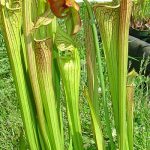
SPECIES INFORMATION: Commonly known as the American Pitcher Plant, is considered to be one of the most overlooked species in the world of carnivorous plants. In reality though, plants of this genus are generally among the easiest and most pleasing to grow. Due to the massive number of hybrids that have been produced over time, botanists debate the number of base species of Sarracenia; generally accepted there being 8 to 11. The eight (8) best known being native to North America; primarily the Southeastern portion of the US.
Sarracenia takes its prey using a passive trap, meaning it does not shut to keep the catch in. The plant gets its common name from the traps themselves, which resemble the shape of an urn or pitcher.
GROWING INSTRUCTIONS:
Climate: Since the Pitcher Plant naturally grows in the South eastern states, wet, warm, and humid climate, they are great candidates for indoors growing, such as in a terrarium or on a windowsill. They like a lot of light, and the more they get during the principle growing season the brighter and more colorful the foliage will be. If you grow Sarracenia in a greenhouse, however, partial shade will be necessary, since Sarracenia can comfortably take temperatures up to about 85 degrees Fahrenheit. They can withstand high temperatures, but severe overheating (as in a greenhouse) will kill the plant.
If you choose to grow outdoors, put the plant in full sun, and make sure it doesn't get too cold at night (Pitcher Plants can only tolerate an infrequent light frost). Sarracenia flava has been known to take temperatures down to 10F, however that isn’t recommended. Also the purpurea purpurea and the purpurea purpurea heterophylla both can take low temperatures do to their native habitat.
Soil: Sarracenia’s grow best in a mix soil, generally one with the principle ingredient being sphagnum peat. One recommended recipe is: 2 parts peat to 1 part perlite or pumice to 1 part sand
If you choose to repot your plant, make sure only to do it during the beginning of the growing season, early spring. A Pitcher plant transplanted out of season will almost certainly die, unless kept in the shade for at least a week and gradually brought back out into full sun.
Dormancy: Sarracenia have a mild need for a dormancy period, but it is still an important factor in the plant's overall health. On average, 3 months at just under 45 degrees Fahrenheit will suit the plant best. If kept this way, the leaves will remain throughout the dormancy period and growing will be much easier in the spring. If kept at higher temperatures during the rest, the plants health may decline and flowering will be sporadic at best.
Feeding: Sarracenia are very attractive plants to insects, and can naturally catch enough prey on it's own. It is not necessary to feed these plants, nor is it to fertilize them. They have also adapted a weak amount of photosynthesis, to make up for what nutrients they don't receive in the insects. In the wild these plants can devour thousands of insects in its life time.
Propagation: The Sarracenia's flower is structured so that naturally, insects must cross-pollinate them to produce seeds. You can do so yourself by moving pollen from the stamen of one flower to the stigma of another using something such as a brush or feather. Keep the seeds in the refrigerator over the winter at about 35-40 degrees Fahrenheit, and then sow them in very moist soil using the normal soil recipe for Sarracenia. You can also cut a portion of the rhizome off, at least an inch long, making sure you get some of the leaves and the roots with them. Take the cutting only from a strong, mature plant, and only during the spring.
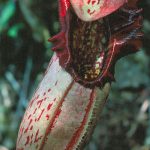
SPECIES INFORMATION:
Nepenthes, or the tropical pitcher plant, are once again a passive trap plant, whose traps resemble the shape of an urn or pitcher. The genus is divided into two main groups, highland and lowland Nepenthes. It is home to some of the carnivorous plants' biggest pitchers, and the oldest of Nepenthes plants have been known to have eaten small birds. These are some of the most sought after plants in cultivation and are perhaps some of the most deadly. These plants can grow to be all different sizes and even the pitchers take on different shapes. For a better look at the diverse looking species, check out the photos page.
GROWING INSTRUCTIONS:
Climate:
Highland: Grows in mildly humid to semi-arid climates, with temperatures best in the range of 65-85 degrees Fahrenheit
Lowland: Usually more in tropical zones, the lowland Nepenthes best takes 55-80 degrees Fahrenheit and a considerably higher humidity.
Soil:
All tropical pitcher plants have a tendency to grow in rather course soils, so to reproduce the natural conditions:
- 2 parts fir bark to 2 parts perlite to 1 part course peat
- Pure sphagnum
- 3 parts fir bark to 1 parts perlite to 1 part sand to 1 part peat.
Watering: The tray method is not very good for this plant, as it does not take well to standing in water. Water it just enough to keep the soil moist, especially during the summer. Nepenthes is one of the most tolerant of impure water, but purified or rain water is still the best for the plant, as is with most other carnivores.
Dormancy:
The best thing you can do for your nepenthes of either type during the winter is to decrease temperatures only a little and water less, only enough to keep the plant moist. Leaves will brown and die, trap formation will cease. (Too much water during dormancy can cause root rot) Dormancy must be observed however none the less.
Feeding: A light foliar feeding of strength 1/8 to 1/4 once a month during the winter months will benefit the plant, but an insect into the trap, especially crickets will be even better. Dead insects depending on the size of the trap will fare it well.
Propagation: A light foliar feeding of strength 1/8 to 1/4 once a month during the winter months will benefit the plant, but an insect into the trap, especially crickets will be even better. Dead insects depending on the size of the trap will fare it well.
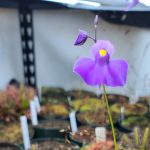
SPECIES INFORMATION:
There are around 300 species of Utricularia distributed throughout the world for the tropics to the artic. These plants can be terrestrial (grown in a planting media), epiphytic (growing on the top of media) or aquatic (growing in acidic water) depending on the species, with some aquatics adaptable to epiphytes. These plants produce carnivorous traps where you would normally find roots on other plants. They put down rootless stem into the media, and on this stem small traps form to capture and microorganism in the media and use this as a natural fertilizer. To grow these plants use a mix of 50% peat moss and 30% sand and 20% pumice or straight sphagnum. Make sure the peat moss hasn’t been treats with any fertilizer. These plants like indirect sunlight with temperatures not dipping below 45 degrees at night. They also like to be kept very wet almost submerged. This entire genus produces small orchid type flowers, when given the right conditions.
